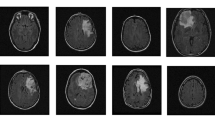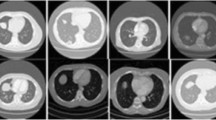Abstract
Objective
We aimed to develop deep learning classifiers for assessing therapeutic response on bone scans of patients with prostate cancer.
Methods
A set of 3791 consecutive bone scans coupled with their last previous scan (1528 patients) was evaluated. Bone scans were labeled as “progression” or “nonprogression” on the basis of clinical reports and image review. A 2D-convolutional neural network architecture was trained with three different preprocessing methods: 1) no preprocessing (Raw), 2) spatial normalization (SN), and 3) spatial and count normalization (SCN). Data were allocated into training, validation, and test sets in the ratio of 72:8:20, with the 20% independent test set rotating all scans over a five-fold testing procedure. A Grad-CAM algorithm was employed to generate class activation maps to visualize the lesions contributing to the decision. Diagnostic performance was compared using area under the receiver operating characteristics curves (AUCs).
Results
The data consisted of 791 scans labeled as “progression” and 3000 scans labeled as “nonprogression.” The AUCs of the classifiers were 0.632–0.710 on the Raw dataset, were significantly higher with the use of SN at 0.784–0.854 (p < 0.001 for Raw versus SN), and higher still with SCN at 0.954–0.979 (p < 0.001 for SN versus SCN). Class activation maps of the SCN model visualized lesions contributing to the model’s decision of progression.
Conclusion
With preprocessing of spatial and count normalization, our deep learning model achieved excellent performance in classifying the therapeutic response of bone scans in patients with prostate cancer.





Similar content being viewed by others
References
Siegel RL, Miller KD, Fuchs HE, Jemal A. Cancer statistics, 2022. CA Cancer J Clin. 2022;72:7–33. https://doi.org/10.3322/caac.21708.
Coleman RE. Clinical features of metastatic bone disease and risk of skeletal morbidity. Clin Cancer Res. 2006;12:6243s-s6249. https://doi.org/10.1158/1078-0432.Ccr-06-0931.
Schaeffer E, Srinivas S, An Y, Armstrong AJ, Barocas D, Chapin B, et al. NCCN Clinical Practice Guidelines in Oncology. Prostate Cancer. Version 4.2022. 2022. Accessed May 18 2022.
Mottet N, Cornford P, van der Bergh RCE, Briers E, De Santis M, Fanti S, et al. EAU Guideline - Prostate Cancer. Edn. presented at the EAU Annual Congress Amsterdam. 2020.
Scher HI, Morris MJ, Stadler WM, Higano C, Basch E, Fizazi K, et al. Trial design and objectives for castration-resistant prostate cancer: updated recommendations from the prostate Cancer Clinical Trials Working Group 3. J Clin Oncol. 2016;34:1402–18. https://doi.org/10.1200/jco.2015.64.2702.
Apiparakoon T, Rakratchatakul N, Chantadisai M, Vutrapongwatana U, Kingpetch K, Sirisalipoch S, et al. MaligNet: semisupervised learning for bone lesion instance segmentation using bone scintigraphy. IEEE Access. 2020;8:27047–66. https://doi.org/10.1109/ACCESS.2020.2971391.
Papandrianos N, Papageorgiou E, Anagnostis A, Feleki A. A deep-learning approach for diagnosis of metastatic breast cancer in bones from whole-body scans. Appl Sci. 2020;10:997. https://doi.org/10.3390/app10030997.
Papandrianos N, Papageorgiou E, Anagnostis A, Papageorgiou K. Bone metastasis classification using whole body images from prostate cancer patients based on convolutional neural networks application. PLoS ONE. 2020;15: e0237213. https://doi.org/10.1371/journal.pone.0237213.
Zhao Z, Pi Y, Jiang L, Xiang Y, Wei J, Yang P, et al. Deep neural network based artificial intelligence assisted diagnosis of bone scintigraphy for cancer bone metastasis. Sci Rep. 2020;10:17046. https://doi.org/10.1038/s41598-020-74135-4.
Han S, Oh JS, Lee JJ. Diagnostic performance of deep learning models for detecting bone metastasis on whole-body bone scan in prostate cancer. Eur J Nucl Med Mol Imaging. 2022;49:585–95. https://doi.org/10.1007/s00259-021-05481-2.
Jin C, Yu H, Ke J, Ding P, Yi Y, Jiang X, et al. Predicting treatment response from longitudinal images using multi-task deep learning. Nat Commun. 2021;12:1851. https://doi.org/10.1038/s41467-021-22188-y.
Hamaoka T, Madewell JE, Podoloff DA, Hortobagyi GN, Ueno NT. Bone imaging in metastatic breast cancer. J Clin Oncol. 2004;22:2942–53. https://doi.org/10.1200/jco.2004.08.181.
Marstal K, Berendsen F, Staring M, Klein S. SimpleElastix: A user-friendly, multi-lingual library for medical image registration. Proceedings of the IEEE conference on computer vision and pattern recognition workshops 2016. p. 134–42.
Beare R, Lowekamp B, Yaniv Z. Image segmentation, registration and characterization in R with SimpleITK. J Stat Softw. 2018. https://doi.org/10.18637/jss.v086.i08.
Yaniv Z, Lowekamp BC, Johnson HJ, Beare R. SimpleITK image-analysis notebooks: a collaborative environment for education and reproducible research. J Digit Imaging. 2018;31:290–303. https://doi.org/10.1007/s10278-017-0037-8.
Lowekamp BC, Chen DT, Ibáñez L, Blezek D. The design of SimpleITK. Front Neuroinform. 2013;7:45. https://doi.org/10.3389/fninf.2013.00045.
Klein S, Staring M, Murphy K, Viergever MA, Pluim JP. elastix: a toolbox for intensity-based medical image registration. IEEE Trans Med Imaging. 2010;29:196–205. https://doi.org/10.1109/tmi.2009.2035616.
Shamonin DP, Bron EE, Lelieveldt BP, Smits M, Klein S, Staring M. Fast parallel image registration on CPU and GPU for diagnostic classification of Alzheimer’s disease. Front Neuroinform. 2013;7:50. https://doi.org/10.3389/fninf.2013.00050.
Seo SY, Kim SJ, Oh JS, Chung J, Kim SY, Oh SJ, et al. Unified deep learning-based mouse brain MR segmentation: template-based individual brain positron emission tomography volumes-of-interest generation without spatial normalization in mouse Alzheimer model. Front Aging Neurosci. 2022;14: 807903. https://doi.org/10.3389/fnagi.2022.807903.
Han S, Oh JS, Kim YI, Seo SY, Lee GD, Park MJ, et al. Fully automatic quantitative measurement of 18F-FDG PET/CT in Thymic epithelial tumors using a convolutional neural network. Clin Nucl Med. 2022;47:590–8. https://doi.org/10.1097/rlu.0000000000004146.
Selvaraju RR, Cogswell M, Das A, Vedantam R, Parikh D, Batra D. Grad-cam: Visual explanations from deep networks via gradient-based localization. Proceedings of the IEEE international conference on computer vision; 2017. p. 618–26.
DeLong ER, DeLong DM, Clarke-Pearson DL. Comparing the areas under two or more correlated receiver operating characteristic curves: a nonparametric approach. Biometrics. 1988;44:837–45.
Johnson JM, Khoshgoftaar TM. Survey on deep learning with class imbalance. J Big Data. 2019;6:27. https://doi.org/10.1186/s40537-019-0192-5.
Bae JB, Lee S, Jung W, Park S, Kim W, Oh H, et al. Identification of Alzheimer’s disease using a convolutional neural network model based on T1-weighted magnetic resonance imaging. Sci Rep. 2020;10:22252. https://doi.org/10.1038/s41598-020-79243-9.
Kim HW, Lee HE, Oh K, Lee S, Yun M, Yoo SK. Multi-slice representational learning of convolutional neural network for Alzheimer’s disease classification using positron emission tomography. Biomed Eng Online. 2020;19:70. https://doi.org/10.1186/s12938-020-00813-z.
Zhou B, Khosla A, Lapedriza A, Oliva A, Torralba A. Learning deep features for discriminative localization. Proceedings of the IEEE conference on computer vision and pattern recognition 2016. p. 2921–9.
Funding
This work was supported by the National Research Foundation of Korea (NRF) grant funded by the Korean government (Ministry of Science and ICT; No. NRF-2020M2D9A1094074; 2021R1A2C3009056), and by a grant from the Korea Health Technology R&D Project through the Korea Health Industry Development Institute (KHIDI), funded by the Ministry of Health & Welfare, Republic of Korea (HR18C0016).
Author information
Authors and Affiliations
Contributions
SH, JSO, and JJL contributed to the study conceptualization, data acquisition, data analysis, data interpretation, writing, and editing of the manuscript. SYS contributed to data analysis and writing of the manuscript.
Corresponding author
Ethics declarations
Conflict of interest
The authors declare no conflict of interest.
Ethical approval
All procedures performed in studies involving human participants were in accordance with the ethical standards of the institutional and/or national research committee and the principles of the 1964 Declaration of Helsinki and its subsequent amendments or comparable ethical standards.
Informed consent
This retrospective study was approved by local institutional review board (IRB No. 2022–0672). The needs for informed consent were waived by the committee.
Additional information
Publisher's Note
Springer Nature remains neutral with regard to jurisdictional claims in published maps and institutional affiliations.
Supplementary Information
Below is the link to the electronic supplementary material.
Rights and permissions
Springer Nature or its licensor (e.g. a society or other partner) holds exclusive rights to this article under a publishing agreement with the author(s) or other rightsholder(s); author self-archiving of the accepted manuscript version of this article is solely governed by the terms of such publishing agreement and applicable law.
About this article
Cite this article
Han, S., Oh, J.S., Seo, S.Y. et al. Performance of deep learning models for response evaluation on whole-body bone scans in prostate cancer. Ann Nucl Med 37, 685–694 (2023). https://doi.org/10.1007/s12149-023-01872-7
Received:
Accepted:
Published:
Issue Date:
DOI: https://doi.org/10.1007/s12149-023-01872-7




